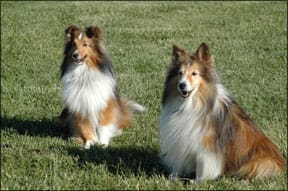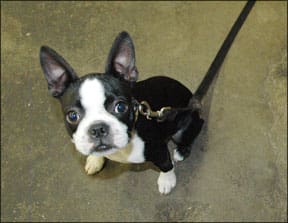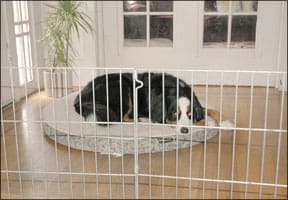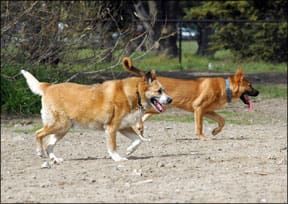Can older dogs and younger dogs live happily together? Will a puppy bounding around (and possibly on) the arthritic body of an older dog encourage her to be more active, bringing energy and vitality during senior years? Or will the perfectly normal antics of a young dog aggravate and stress what should be a time of happy retirement for a senior dog?
If you’ve lived with an older dog, you’ve probably heard someone at some point recommend getting a puppy or younger dog. The advice may be something like, “It will keep your older dog young,” or “The new puppy can learn from your older dog.”
While you will likely find some truth in both statements, the opposite may also hold true. Your older dog could be stressed or exhausted by a younger dog. Your young dog will certainly learn from your older dog, but the lessons may not be those you would like to be passed from one generation to the next.

While every multi-dog household has its challenges and most have tremendous joys, adding a very young dog to a household made up of one or more senior dogs can bring about a special set of challenges. However, if you find yourself living with an older dog and younger dog (or like me, actively choose to do so in spite of knowing the challenges) you can take steps to ensure the experience is the best for both young and old.
How Old is an Old Dog? What Counts as Young?
Because age is relative to breed, size, and overall health and condition, for the purpose of this article, I’ll define “older” as any dog that has settled into “retirement.” This is not a function of numeric age, but rather defined by the dog’s place in his or her life cycle.
An older dog may occasionally still enjoy a game of ball or a few minutes of romping with another dog, but for the most part he or she really prefers quiet and comfortable companionship. An older dog is more likely to sleep a little longer, move a little slower, and tire a little sooner. He or she may have changing senses – be less able to hear, see, and smell – or may live with the constant pain of arthritis. An older dog may have a chronic or hidden illness or be in the last stages of life. An older dog may be a “senior” dog or a “geriatric” dog.
A “young” dog can be a puppy or an adolescent. As with older dogs, adolescence is relative and adolescent behavior may be evident from six months to three or more years of age. Just as it is appropriate for an older dog to be in retirement mode, it is imperative for a young dog to explore the world with gusto. Young dogs (and especially adolescent dogs) need to come to terms with who they are and their role in their world. It is a time for experimenting with behavior, and, like human adolescents, testing limits.
Why Does Age Matter in Dog Packs?
Younger dogs and older dogs often have dramatically differing needs. Older dogs need quiet and comfort; young dogs need activity, excitement, and challenge. Keep in mind that these needs can create conflict in your home!
For example, puppies can be a bother to an older dog who is tired, ill, or would rather just sleep in a spot of sun. They are not very good at remembering manners (“Oh, gee, that’s right. You did tell me not to pounce on your head or bite your ears two minutes ago . . . but I forgot!”). They can be relentless in their need for attention and play (“Come on, don’t you want to play? How about now? What if I prance with this toy? How about if I nibble on your toes? Not yet? What about now?”).
While an adult dog with plenty of energy and good social skills may enjoy a puppy’s antics and be comfortable setting limits when needed, a senior or geriatric dog may be more easily exhausted or may even be intimidated as the pup grows into a strapping young adolescent.
The most serious problems I’ve seen when mixing older and younger dogs occur when puppies become adolescents, and these problems can be amplified if the older dog has health issues. While a puppy may be an innocent pest, willing to back off when asked, an adolescent dog has a greater tendency to push limits. Adolescent play styles are often rough: bouncing, bashing, and slamming bodies. Many explore the world as if they are made of steel (and expect the rest of the world to be made of steel, too). While this is perfectly normal, even appropriate, for the adolescent and young adult dog, the impact on our senior companions can be seriously annoying or even downright dangerous.
A senior or geriatric dog may also be gruffer than a pup deserves. An older dog who does not feel well, for example, may be less tolerant of normal puppy behavior.
In addition, an older dog with compromised hearing and vision may have a harder time responding appropriately to the body language of the young dog. A dog whose movement is limited or who may be in pain may not communicate as effectively. The result can be inconsistent signals or what appears to be more abrupt communication, which can cause confusion in the relationship between the two dogs. While these types of scenarios are not a given, they are not uncommon. And, the result of these conflicts can vary dramatically. At best, the older dog will set limits, and the younger dog will respect them. At worse, one of the dogs will be injured (or even killed) in a serious conflict.
Most often, of course, the impact is subtler and somewhere in between. An older dog who is disturbed by puppy or adolescent antics may remove himself from the family in an attempt to avoid the chaos. The younger dog may learn that his rough behavior is fun, and learn to pester or bully other dogs.
Action Plan
In a household of dogs with dramatically differing needs, accepting that all is not equal is the key. And remember, meeting the needs of your individual dogs can provide all of you with great pleasure. You can enjoy hanging out quietly (perhaps reading your favorite dog magazine) with your older dog. You can enjoy active romps with your youngster. By providing for differing needs, you will get to spend special time with each dog and special time with them together. In addition, you will help prevent problems before they creep up.

Prevention First
Prevention is a powerful tool. It means understanding the realities of life with dogs of differing ages, and taking the steps to insure all dogs are happy and relaxed. Prevention is partially about managing the environment, and partially about proactively managing behavior. Each situation is different, and some dogs require more help via management, and many will need less.
• Provide separate spaces. When you are home, make sure all dogs have a space to which they can retreat in peace. It may be a crate or a bed. Help your young dog learn that when the older dog goes to his place, the youngster needs to find something else to do. When you see your senior dog head for his bed, use that as a cue to give the pup a nice bone or food-stuffed Kong and put him in a crate for a while.
When you are away from home, you will likely want to separate the dogs for safety. While many of us use crates, exercise pens, and baby gates with puppies, you may need to continue using them as your young dog becomes an adolescent and as your older dog moves from retirement into geriatric care. Just as it is not wise to leave a very young puppy unsupervised with an adult dog, it is not appropriate to leave a very old and vulnerable dog alone with younger dogs.
• Manage exciting times. You may also want to separate your young and old dogs during high arousal times, especially while the younger dog is learning manners. For example, in our household, getting ready to go out and returning home are very exciting times – as well as critical times for managing a jumping, bouncing puppy around the equally excited, but less agile old girls.
We now put one or all of the dogs in kennels or separate spaces during high arousal times, and this has dramatically reduced conflict and the risk of accidental bumps and bangs. Our youngest dog enthusiastically runs to her kennel – and is visibly relieved to be out of the path of the grumpy old ladies when we come home or get ready to go out.
• Consider feeding the dogs separately, too. Your older dog may be slowing down in eating. Dental problems are common in older dogs. In addition, when you are talking about vast differences in ages and abilities, it is best not to set up competition for resources. Consider separating the dogs when giving high value chews, stuffed Kongs, and bones, too.
• Support the needs of both young and old! Make sure all dogs have individual attention from you. Your younger dog may enjoy heading out for a long hike or off to training class with you, while the older dog may enjoy a ride in the car or a walk to the neighborhood park.

Support your young dog needs:
• Plenty of exercise. Remember the exercise needs of a young dog are greater than those of an older dog.
• Appropriate playmates. Make sure your younger dog has social interactions with dogs closer to her age – other dogs who will appreciate her normal exuberance. This can also help wear her out so she is not as likely to bother the senior citizen.
• Rowdy time at home. Younger dogs really do need to blow off steam at certain times. Direct rowdy behavior into activities that do not stress the older dog.
• One-on-one playtime with you! This will help your young dog learn that his or her play needs can be met by someone other than the old dog.
Support your older dog needs:
• Plenty of time to rest and sleep. My older dogs need to sleep much of the day. A puppy’s normal short bursts of sleep and activity can easily disturb an older dog’s much needed rest.
• A stable routine. Routine is an essential element in stress reduction, and a lower stress lifestyle can support your senior citizen’s health as he or she grows older.
• Time for favorite activities. It’s easy for the older dog to take a back seat to the loud and clear needs of a puppy. In addition, a young dog can often do the things you used to enjoy with the older dog and they need the activity. This makes it especially easy to shortchange the needs of a less-demanding older dog. Consider that your older dog needs your attention as much as the young one.
Positive Bonding Times
One of the best ways to insure the happiness of all dogs in a multi-dog household is to make sure they have positive bonding times. For young dogs of a similar age, that may come via rowdy play. For adult dogs, bonding time may take the form of exploring the environment on off-leash outings. Some dogs enjoy snuggling, other find pleasure in a good game of tug.

With a very young dog and an older dog, these natural bonding opportunities may not be as evident. Rambunctious play may not be safe for your senior citizen, and the young dog may not yet be trustworthy in the world for off-leash exploration. But you can provide positive bonding opportunities, even for those dogs with disparate needs.
Non-competitive activities such as on-leash walks are one of the easiest ways for dogs to bond. Sniffing and exploring the world together can bring the dogs closer. Keeping them on-leash can help all remain comfortable and safe.
Sleeping in the same room (with you, ideally) is another way for all to bond. It’s okay for one or more dogs to be crated, if needed. Group training sessions can be great fun for all of the dogs and is a fun and productive way to facilitate bonding. Try practicing calm greetings and doorway manners (especially important skills for older and younger dog groups). In addition, teaching a “stop” during play can be extremely helpful, and a solid group sit and wait are a must for every multi-dog household. Even if your older dog already knows these behaviors, he or she will likely benefit from the training time as it will provide fun with you as well as with the pup.
Keep Everyone Safe
A big concern in a multi-dog household, and especially one with very young and very old dogs, is the question of when to intervene, and when to let the dogs negotiate on their own.
One of the most common situations I’ve seen is when an older dog does not tell a younger dog to mind his manners. The older dog may simply be passive, or may have been scolded by a well-meaning person for being too gruff with the puppy. (It is hard, after all, to watch an older dog growl or correct a puppy for simply wanting to play.) While it is important to monitor interactions, an adult dog giving an appropriate correction for rude puppy behavior is an essential way for the pup to learn to be respectful to other dogs. A puppy that is allowed to push around an older dog, even in play, can easily learn to bully others.
Instead of stopping an older dog from setting appropriate limits, support your older dog by looking for the earliest communications or signs of annoyance. Help your puppy understand that when limits are set, it is time to move away. Redirect your puppy to toys, playing with you, or some quiet time in a crate.
But if your older dog is simply intolerant or grows increasingly grumpy with the youngster over time, you may need to support both dogs by providing separation. Remember that your older dog may not be physically or mentally up for the challenges of a youngster. Support your older dog’s retirement by making sure he or she has the space to be quiet and calm.
And, for the sake of safety, with very old and young dogs, you may want to limit high arousal play (or supervise it closely). High arousal activities can lead to out-of-control behavior in young dogs (high speed zooming around the house or yard, for example!). This is too often a time when a young dog can “blow it” by simply playing too rough or knocking an older dog off of his feet.
Competitive activities such as ball play where they are both chasing and competing for the same ball is another time when conflict can easily develop between two otherwise comfortable companions. If your older dog can no longer play rough, make sure the younger dog has other dogs to roughhouse with instead. As health changes . . .
Both of our two senior dogs were still active, strong, and able to engage with seven-month-old Chance when we first brought her home. While both older dogs were experiencing some health issues, they were still vibrant in spite of their 13 years. Our senior cattle dog-mix, Jesse, played like a puppy with young Chance for the first several months. Blue, never one to enjoy a pup, set about teaching Chance to be respectful of her elders.
Within a few short months, though, the older dogs’ health problems really flared up. As their health declined, their relationships with our young dog changed. All had to learn new, gentler ways to interact. With an older dog, health changes are inevitable. And the relationships between dogs will change as health dictates.
When an older dog becomes ill, the management factor in the household is very likely to change. A successful coping strategy can be to simply cordon off the household. A good friend with two younger dogs and a very ill senior dog told me that she kept the younger dogs separate from the older dog in all but the quietest times of day. This was simply to keep the older dog safe and to allow the younger dogs the freedom to play and be active.
Putting Aside Guilt
For me, perhaps the hardest part of having two geriatric dogs with serious illnesses and one energetic adolescent dog is the guilt that comes from doing activities with one dog and not the others.
It’s hard to kennel a young dog so an old dog can sleep at your feet in peace. It’s equally difficult to leave an older or ill dog at home while you train and play with your younger friend. But by putting guilt aside and managing the environment, all dogs can enjoy life to the fullest, in safety and comfort.
Watching our older dogs become revitalized by the energy of the young dog was certainly a joy to see. Watching Chance seem to develop compassion as the older dogs have become frail has shown us a side of her we might otherwise not have witnessed. Very old and very young dogs living together are certainly a challenge, and not one I would lightly recommend. But like any challenge, when met head on, the rewards can be dramatic.
Mardi Richmond, MA, CPDT, is a writer and trainer living in Santa Cruz, California.







thanks for sharing this tips
This was wonderful and very helpful and we are introducing our senior Great Dane to a 1 year old Great Dane soon. Many of your tips would be been helpful in the past, you live and learn. Thanks!!
I would love to read more tips on how to manage a situation like this. I’m doing nearly all of these within a 600 sf apartment but need more ideas. The “Related Articles” below this one aren’t related–Comforting a dog with fever, helping your dog with PT, and 5 reasons to microchip. Do these comments get read by someone on Whole Dog staff?